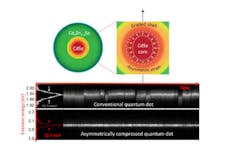Quantum-dot researchers at Los Alamos National Laboratory (LANL; Los Alamos, NM) have found that intentionally squashing colloidal quantum dots (in other words, creating asymmetrical strain) during chemical synthesis creates dots capable of stable, blink-free light emission that is fully comparable with the light produced by dots made with more complex processes.1 The squashed quantum dots emit spectrally narrow light with a highly stable intensity and a nonfluctuating emission energy.
The strained colloidal quantum dots represent a viable alternative to presently employed nanoscale light sources, and deserve exploration as single-particle nanoscale light sources for optical quantum circuits, ultrasensitive sensors, and medical diagnostics.
"In addition to exhibiting greatly improved performance over traditional produced quantum dots, these new strained dots could offer unprecedented flexibility in manipulating their emission color, in combination with the unusually narrow, subthermal linewidth," says Victor Klimov, lead Los Alamos researcher on the project. "The squashed dots also show compatibility with virtually any substrate or embedding medium as well as various chemical and biological environments."
The new colloidal processing techniques allow for preparation of virtually ideal quantum-dot emitters with nearly 100% emission quantum yields shown for a wide range of visible, infrared, and ultraviolet wavelengths. These advances have been exploited in a variety of light-emission technologies, resulting in successful commercialization in, for example, quantum-dot displays and TV sets.
The next frontier is exploration of colloidal quantum dots as single-particle nanoscale light sources. Such future single-dot technologies would require particles with highly stable nonfluctuating spectral characteristics. Recently, there has been considerable progress in eliminating random variations in emission intensity by protecting a small emitting core with an especially thick outer layer. However, these thick-shell structures still exhibit strong fluctuations in emission spectra.
The key in the new LANL approach is to combine, in a core/shell motif, two semiconductors with directionally asymmetric lattice mismatch, resulting in anisotropic compression of the emitting core.
This modifies the structures of electronic states in the quantum dot and thus its light emitting properties. One implication of these changes is the realization of the regime of local charge neutrality of the emitting quantum dot's exciton state, which greatly reduces its coupling to lattice vibrations and fluctuating electrostatic environment, which is key to suppressing fluctuations in the emitted spectrum. An additional benefit of the modified electronic structures is dramatic narrowing of the emission linewidth, which becomes smaller than the room-temperature thermal energy (in other words, it becomes "subthermal").
Source: https://www.lanl.gov/discover/news-release-archive/2019/January/0110-squashed-quantum-dots.php
REFERENCE:
1. Young-Shin Park et al., Nature Materials (2019); doi: 10.1038/s41563-018-0254-7.

John Wallace | Senior Technical Editor (1998-2022)
John Wallace was with Laser Focus World for nearly 25 years, retiring in late June 2022. He obtained a bachelor's degree in mechanical engineering and physics at Rutgers University and a master's in optical engineering at the University of Rochester. Before becoming an editor, John worked as an engineer at RCA, Exxon, Eastman Kodak, and GCA Corporation.
